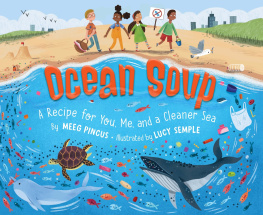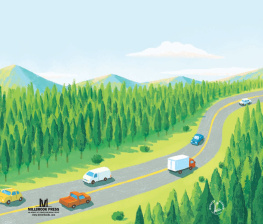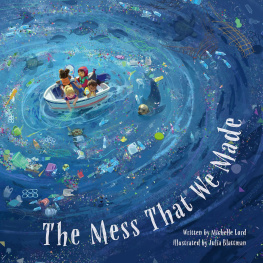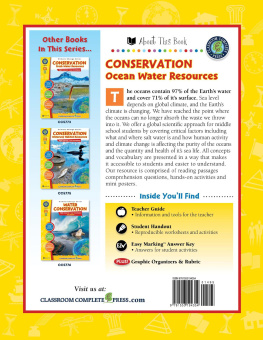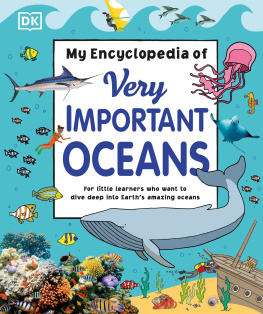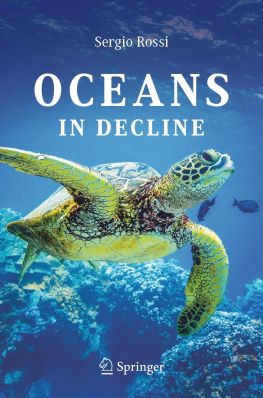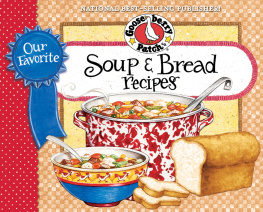Table of Contents
Guide
Page List
From afar the vast ocean appears pure and clean.
How it sparkles and shimmersa beautiful scene.
But dig in a bit deeper and test a small scoop,
and youll see that, up close,
the sea looks more like...
SOUP!
Ocean Soup has been stewing for decades of days.
Its been simmered by sun
and congealed under haze.
Many chefs made this murky, confetti-like brew
a concoction of habits that bubbled and grew.
It began when a new crop of products first came,
used by folks unaware theyd be later to blame.
They drank coffee from Styrofoam cups topped with lids.
And at stores they took throwaway bags without pause.
Do you wonder how all this produced Ocean Soup?
How such everyday habits made saltwater goop?
The real problem is plastic; its in all that stuff.
Whether hard or elastic, that plastic is tough!
Once its made, any plastic is with us to stay.
Its on Earth till forevertheres no real away .
People throw out their plastic and think that its gone,
but most dumps overflow; excess trash just moves on.
cnneeMus,teteroweawnr.
whnta,cile.Ases,tensc,
Onsseiehe,ilptmv.
Yet its gulped by the dolphins, the whales, and the seals,
and its slurped by the fish,
and the plankton
and eels.
Its in icebergs,
in inlets,
the deep ocean floor.
Itstdbs,
the turtles,
and more.
Ocean Soup fills the bellies of all in the sea.
(And if we eat fish too, is it in you and me?)
Are you wishing those chefs had not
cooked up this mess?
That theyd known one-use products
would cause such distress?
It is time for us new chefs to enter the scene
with a recipe crafted to get our seas clean.
First, we call on the makers, go straight to the top.
Tell them all of this plastic production must stop!
Then, we practice new habitspreventing more stew
with reusable items and natural ones, too.
This wont always be easy; well all have to think
to remember our bottles and straws when we drink.
Anrtscs-cot.
Les,es!Whres?
Ocean Soup may have simmered before we were here,
but the call for us all to pitch in rings out clear.
We will need many chefs to help clean up the sea
starting here in our kitchen, with you, and with me.
What is Ocean Soup?
Ocean Soups roots began in the 1940s, when inventors created plastic from leftover waste materials of coal, oil, and gas. In the 1950s, companies touted it as a cheap, light, throwaway material and began mass-producing it in many forms. People got used to plastic. Companies today produce nearly 400 million tons of it yearly, less than 10 percent of which is recycled.
This has led to what we call in this book Ocean Soup: the more than 51 trillion particles of plastic smog taking over the Earths oceans. (Thats 500 times more plastic particles in the sea than stars in the galaxy!)
It starts with larger plastic pieces that land in the ocean and get sucked into five huge subtropical whirlpools called gyres (rhymes with tires). One, the North Pacific Gyre, is nicknamed The Great Pacific Garbage Patch, which makes it sound like we can see all the trash there and just clean it upbut we cant.
The gyres circular currents are so strong that a piece of plastic will swirl around for 10 years or more (like a verrrrry long toilet flush!). Amid the currents, waves, and ultraviolet light, plastics in the gyres become brittle and break down into microparticles smaller than grains of rice. These seep out into seawater around the globe, creating a toxic soup thats impossible to separate.
These are the top four types of plastic that pollute
the worlds seasOcean Soups main ingredients:
Plastic Bags. Americans use
1 million plastic bags every
minute only 1 percent of
which are recycled.
Plastic Bottles. We use
3 million plastic water
bottles every hour .
Plastic Straws.
We use 500
million plastic straws
every day .
Styrofoam Cups and
Containers. And we use
25 billion Styrofoam coffee
cups every year less
than 2 percent of which
are recycled.
These plastics are the next most common
Ocean Soup ingredients:
Microfibers. Some
1.4 trillion plastic
threads from materials
like polyester, nylon, and spandex
(think bathing suits, fleece jackets,
exercise clothing) have flowed into
the ocean, mostly from our home
washing machines.
Fishing Gear. Nearly
1.3 billion pounds of
plastic fishing lines, nets,
and weights also end up in
the ocean each year.
Balloons. The amount
of plastic balloons and
balloon pieces found
on beaches has tripled
over the past 10 years.
Microbeads. Eight billion tiny
plastic balls from toothpastes
and soaps have washed down
US sinks and showers each
day for years. (However,
thanks to activists, the
US and UK recently
banned microbead
products!)
Remember, none of this plastic will ever fully disintegrate! Our oceans and all the
life-forms in themare in big trouble. What a mess! So, what can we do about it?!
A Recipe for Cleaner Oceans (in 10 Steps)
We can make a difference! Heres a real-life recipe for how we can reduce
our daily plastic use and help save our world s oceans, wherever we live .
1. Start at the top! Tell companies you want natural, biodegradable, and
recycled materialsno more new or single-use plastic! Ask lawmakers to
create new laws against producing harmful plastics. (Marine scientists
say our best bet to save the oceans is to stop mass plastic production at
the source.)
2. Stop and think before you buy stuff. Ask: do I really need this? Say
no to plastic products and packaging, especially single-use plastic and
those top four polluters, whenever you can. Remember: refuse comes
before reduce, reuse, and recycle!
3. Commit to reusable products. Carry reusable bags, water bottles,
straws, and silverware. Reuse containers for food or household cleaners;
try bulk refills or DIY recipes.
4. Wear more natural fabrics. Instead of polyester, nylon, and spandex,
choose 100% cotton, bamboo, or hemp fabrics. And wash your microfiber
clothes infrequently. (You can also add an insert or attachment to your
washing machine to catch microfibers.)
5. Use alternatives to balloons for parties or gifts. Try paper streamers,
banners or cards, tissue paper pom-poms, or, best yet, real flowers.
6. Pass on fishing. Or, if you must fish, keep your fishing lines and nets
from falling into the sea! (You may also want to rethink eating fish
scientists are still trying to determine how much of the plastic eaten by
fish ends up in the bodies of human fish eaters.)
7. Join cleanups of your local waterways. Whether its a lake, river, or
oceanits all connectedtheres plastic to be picked up.
8. Find out how to properly recycle or dispose of the plastics you use.
Many of us throw unrecyclable or soiled plastics into recycle bins, which
can mean the whole batch theyre in wont get recycled. Check with your
local recycling center for guidelines.
9. Help your communities move toward zero waste. Work with your
family, school, city, place of worship, or any local group or business to
create zero-waste, plastic-free practices and goals.
10. Keep learning! Check out other books, the 5 Gyres Institutes Trash
Academy (www.5gyres.org/trash-academy-lessons) and National
Geographic s Kids vs. Plastic (kids.nationalgeographic.com/explore/

